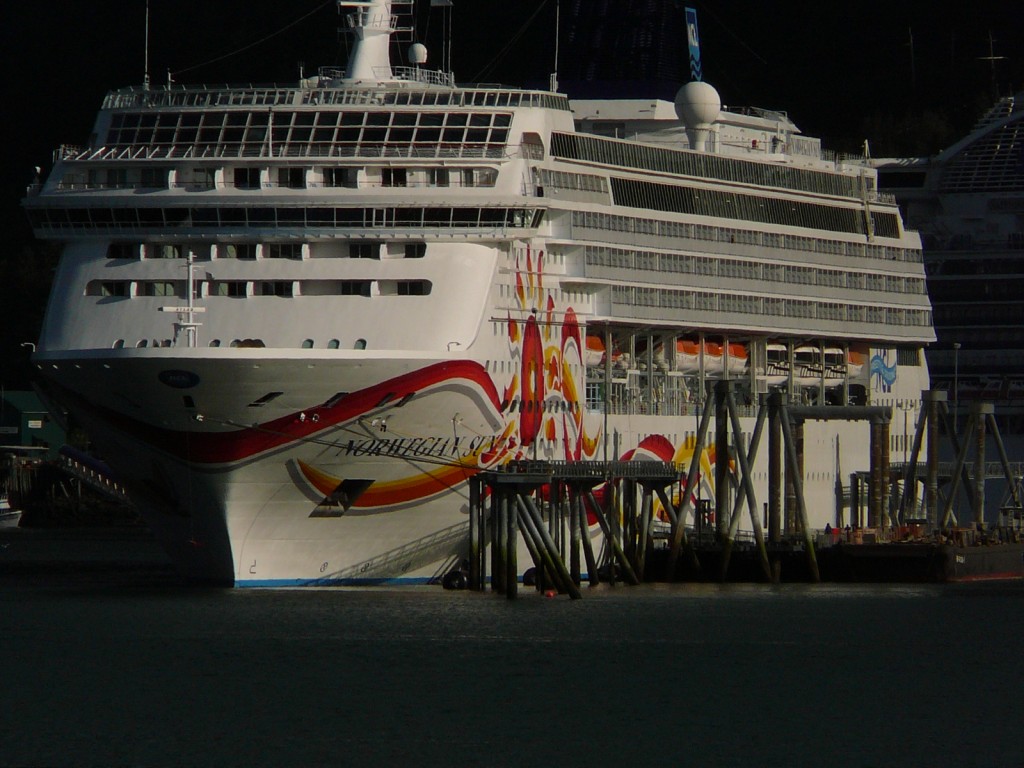
Norwegian Cruise Line says it will sail another ship in Alaska waters.
Company officials this week announced plans to return the Norwegian Sun to northern service two seasons from now. It last sailed here in 2009.
The Sun will sail from Vancouver to Whittier and back beginning in May of 2013.
Northbound cruises will stop at Ketchikan, Juneau, Skagway, Glacier Bay and the Hubbard Glacier near Yakutat. Southbound itineraries will be similar, adding Hoonah’s Icy Strait Point and Tracy Arm south of Juneau, and skipping Glacier Bay.
Crane Gladding of Norwegian Cruise Line says each week-long trip will carry about 2,000 passengers. That adds up to around 40,000 for the season.
“We really feel like the time is right. And it really feels like with the cooperation of the government and the folks in Alaska that we’ve really seen a lot of improvement in the demand for the overall product,” Gladding says.
He says better marketing and improvements in docks and shoreside facilities helped his company decide to return. So did a reduction in the voter-approved cruise ship passenger fee, which dropped from $50 to about $25 dollars this last season.
Governor Sean Parnell and the Legislature credit that change for bringing more ships to the state. So does Ron Peck, of the Alaska Travel Industry Association.
“By reducing the liability on the head tax, I absolutely believe that had an impact on cruise executives decisions and that’s great news for Alaska,” Peck says.
Industry critics disagree on the reason the Sun is leaving the Baltic Sea for Alaska.
Chip Thoma, of Responsible Cruising in Alaska, says international politics, not tax cuts, are bringing ships back to the state.
“A lot of these ships from Alaska and from the Caribbean went on to Europe thinking they would do well in the Mediterranean. And of course the Arab Spring came and that was just a debacle. So all those ships are coming back to this part of the world and that’s what I attribute all of the interest in Alaska again,” Thoma says.
Norwegian already sails two larger ships on roundtrips through the Inside Passage. The Sun sailed a similar route in 2009, its last Alaska season.
Its new itinerary is one way, dropping passengers off or picking them up in Whittier, the nearest cruise port to Anchorage.
John Binkley, of the Alaska Cruise Association, says that boosts passengers’ economic impact.
“Those people then will be getting on or off the ships in Southcentral Alaska. Many of them will travel then all the way up into the Interior and other parts of Alaska and be spending more money and more time in Alaska,” Binkley says.
Industry figures show cruise capacity peaked at just over a million passengers in 2007. It stayed about the same for two seasons, then dropped to about 880,000 for last and this year.
Next year, Princess will add a seventh ship to its Alaska fleet. And Holland-America is juggling vessels to carry more passengers. That will bring total cruise capacity up to about 950,000.
The Norwegian Sun’s 2013 addition raises passenger counts another 40,000, almost reaching the historic million-cruiser high of the last decade.
Binkley says other deployment announcements could come in the next few months.
“Most of the companies have them finalized now. And then it’s just a question of what their strategy is and when they release those to the public and when they start selling those,” he says.
Alaska cruises can run from the hundreds to the thousands of dollars, depending on the choice of cabin and other amenities.
Norwegian Cruise Line’s Gladding says the Sun’s fares also depend on timing.
“There’s also great opportunities to sail in May, early June and September that offer an affordable price. So I think prices will start at about $699 per person and kind of go up from there as you get into peak times,” Gladding says.
Capacity estimates are based on two people in each stateroom. Actual numbers can be higher or lower, depending on the number of children and others along for the ride.
Ed Schoenfeld is Regional News Director for CoastAlaska, a consortium of public radio stations in Ketchikan, Juneau, Sitka, Petersburg and Wrangell.
He primarily covers Southeast Alaska regional topics, including the state ferry system, transboundary mining, the Tongass National Forest and Native corporations and issues.
He has also worked as a manager, editor and reporter for the Juneau Empire newspaper and Juneau public radio station KTOO. He’s also reported for commercial station KINY in Juneau and public stations KPFA in Berkley, WYSO in Yellow Springs, Ohio, and WUHY in Philadelphia. He’s lived in Alaska since 1979 and is a contributor to Alaska Public Radio Network newscasts, the Northwest (Public Radio) News Network and National Native News. He is a board member of the Alaska Press Club. Originally from Cleveland, Ohio, he lives in Douglas.




